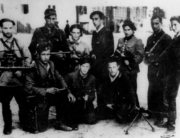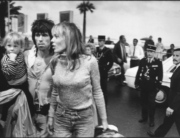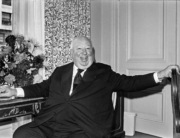DOC NYC may be America’s biggest documentary film festival, but its quality happily matches its quantity. Programmers have put together a collection of thoughtful films featuring intriguing profiles, singular situations, and widely varying styles. Filmgoers sadly can’t kibitz in theater hallways and lobbies this year, but they’ll have plenty to reflect on and talk about.
ACASA, MY HOME

Focused on a Romanian Roma family living off the grid in the dusty flatlands around Bucharest, the intimate, lyrically filmed Acasa, My Home feels a lot like 2019’s Honeyland. Outside forces threaten natural harmony, only this time cloaked in do-gooder progress rather than naked greed.
Patriarch Gica Enache presides over nine rambunctious kids in a tarpaper shack by the shores of Lake Vacaresti. The children fish, swim, and help their parents live off the land. Scenes of the youngsters at play in the gloaming suggestion an earthly paradise; fluid, light-dappled camerawork won the film the World Cinema Documentary Special Jury Award for Cinematography at Sundance. Ominously, a long drone shot stretches over suburbia, wordlessly showing it encroaching on the once-isolated lake. Change is coming, and fast.
Bureaucrats announce that Bucharest will turn the area into a nature reserve, a decision implied to be an attempt to copy more trendy European cities. Environmentalists, city planners, and even Prince Charles grandstand on the banks of the lake, while social workers get busy efficiently dislodging the family. The Enaches wind up frog-marched into a densely populated city with harsh, unfamiliar rhythms.
Glumness settles in as the family faces its new surroundings. So does slapdash rebellion—this crew is tougher and scruffier than Honeyland’s saintly beekeeper. Power structures inevitably shift within the group. Four years in the making by journalist Radu Ciorniciuc, Acasa, My Home casts a bittersweet, empathetic eye on unwanted change and how refugees from a lost idyll live with it.
CALENDAR GIRL

Fashion documentaries often trot out big guns like Anna Wintour to make lavish claims of genius on behalf of high-profile designers. But Calendar Girl offers a cozier, gentler picture of the fashion world with its portrait of 95-year-old fashion doyenne Ruth Finley.
Finley created a calendar in 1945 that laid out the times and dates of upcoming designer shows. Over the years as fashion exploded, Finley became more than just a scheduler but a gatekeeper and hidden influencer. Filmmaker Christian D. Bruun follows Finley on a poignant occasion, the handing over of her life’s work to the Council of Fashion Designers of America. The tiny, frail Finley still makes the rounds of designer shows at Lincoln Center, dwarfed by towering models and trailed by her assistant Mary Hackley as she meets and greets friends at all levels of the business.
Designers like Thom Browne, Nanette Lepore, and Nicole Miller attest to Finley’s impact on the industry. Lesser-known figures weigh in with articulate comments too. The tributes seem more heartfelt and less calculated than the usual fashion encomia, although fashion being what it is, one does detect a whiff of condescension—Finley has lost clout and is no longer competition. Still, insiders’ warm regard for the nonagenarian is impressive.
The fashion kingpins note more than Finley’s hand in fashion. They also call out her optimism and tenacity. Calendar Girl’s scope accordingly widens beyond work to reveal Finley as a divorcee, widow, and single mother who soldiered through setbacks to stick to her project and vision. And on the north side of 90, she even has what so many younger straight women in New York find elusive—a boyfriend. What was her secret? “I was always looking at the happy side, and too many people don’t know how to do that.” Finley died in 2018 at 98. With its worldly air and bouncy score, this documentary does her legacy proud.
TINY TIM: KING FOR A DAY

Was there any entertainer as delightfully strange as Tiny Tim? The scraggly-haired crooner shocked audiences way back in the 1960s, and a listen to his yodeling, unhinged vocals is baffling even now.
John von Sydow’s rich, perceptive biography traces the singer’s miserable beginnings as Herbert Butros Khoury, the lonely son of mismatched immigrant parents in Washington Heights. From childhood, young Herbert suffered from self-reproof, mild religious mania, and romantic delusions of omnipotence. Rudimentary but vivid animation brings his conflicted inner life into view. In time, Herbert selected a new name, picked up on the 1960s free-spirit vibe of Greenwich Village, and began busking, performing, and then recording. Yoko One and the late Jonas Mekas are on hand to describe the Tiny Tim experience, the latter still sounding a little bewildered: “That voice is not from here!”
Tiny Tim’s campy but vulnerable performances of daffy tunes like “Tiptoe Through the Tulips” somehow struck a chord in Middle America. Soon Tiny Tim was making the celebrity rounds on Johnny Carson and the variety shows. In a forerunner of reality TV, he even got married on The Tonight Show before an audience of 40 million. But audiences soon moved on from Tiny Tim, and a long, sad downward spiral began, involving brushes with the Mafia, tours with the circus, and a move back in with his mother before his death in 1996.
Tiny Tim’s story bears a lot of (cautionary) relevance to modern celebrity, and his (tame) gender-bending invites a lot of contemporary commentary. Even his ukulele has made a comeback. But von Sydow holds back from overinterpretation and allows well-selected archival footage, Tim’s diaries, and interviews with those who loved him to tell the story. It’s an artful yet unadorned approach that suits an entertainer so kooky and yet so uncannily real.
KENNY SCHARF: WHEN WORLDS COLLIDE
Naiveté came naturally to Tiny Tim. For artist Kenny Scharf, is it schtick? Directed by Max Basch and Scharf’s daughter Malia Scharf, Kenny Scharf: When Worlds Collide should offer rare access, but for all the art star’s colorful eccentricity, he seems concealed behind a mask of boyish detachment. It’s not to any real detriment, though. Kenny Scharf is plenty entertaining without an emotional overshare.
Scharf grew up in Populuxe 1960s California, a fertile source for an obsession with mass culture. In the late 1970s, he made his way to New York City with the ambition of emulating his idol, Andy Warhol. At the School of Visual Arts, “where they take anyone,” he met Keith Haring, an instant friend and future rival. He and Haring joined Jean-Michel Basquiat to turbocharge a hyperactive scene of street art, new music, nightclubbing, and provocation. Chronicler Carlo McCormick recalls, “There was a lot of infantilism and childish behavior,” and even now Scharf cops to a Peter Pan syndrome. But the 1980s was the right time for the oeuvre’s mix of snark and childlike wonderment. Critics liked the energy, gallerists enjoyed Scharf’s endlessly prolific output, and clubbers were drawn to his lean, blue-eyed good looks. Soon Scharf was riding a wave of fame and riches.
Until it crashed. Like Warhol, Scharf is given to vague oh-wow talk, so it comes as an opening-up when he reveals the hurt and insecurity he felt when the art world left him behind for new flavors of the decade. Haring’s death from AIDS was also a terrible blow. Scharf grapples with his feelings here, and the moments are powerful.
But glimpses of pain aside, the film reassures us that Scharf has emerged in the clear. In what looks like a maneuver toward reputation rehab, every art expert in the business tells us how important his work is as a critique of American culture. Looser moments feature Scharf enjoying his grandchildren, making public art, and affably spray-painting a stranger’s jacket. Creating is his happy place, and he’s always blissfully in it. We may never get to the heart of this elusive artist, but the film offers more than enough on the surface to engage the eye.
LIFT LIKE A GIRL

I haven’t come close to seeing all the films in DOC NY, but I’m willing to bet that Lift Like a Girl features the most effervescent, over-the-top figure in the festival: Captain Ramadan. Captain hectors a squad of tween and teen girl weightlifters who train in a vacant lot on a rundown corner of Alexandria, Egypt. The captain loves to sing. Chant. Holler. “Why are you always yelling?” asks one girl. “Because you’re a bunch of pain-in-the-ass sons-of-bitches!” he yells back.
Captain has produced Olympic and world champions for more than 20 years. He knows his tart yet charming patter motivates the team to win national and international championships. And he not only tolerates unladylike behavior, he insists upon it. In Captain, director Mayye Zayed has fixed on an unforgettable character and created an immersive feel for a world most of us don’t know.
A quiet, introverted girl floats in the weightlifting group, a sort of moon to Captain’s sun. Asmaa’s name means “exalted” in Arabic, but her nickname is the humbler Zebiba, or “raisin.” A win can coax a shy smile to Zebiba’s face, but a lack of self-confidence impedes her obvious strength and talent. “First place was in her pocket, but she lost because she’s an idiot,” snaps Captain after a humiliating loss. Zebiba needs to reckon with her coach, her competition, and herself, and a sudden tragedy will put her tenacity to the test and the group’s future into question.
Lift Like a Girl is a raw affair. Camerawork wavers, the training floor is pockmarked, and weightlifting brings forth loud grunts and ungainly positions. Through the heat and grit, the Captain’s young posse display remarkable warmth, support, humor, and a degree of joshing comfort with boys that dispel stereotypes of Middle Eastern life. The distinctly un-bubbly Zebiba brings a deeper contribution to the range of emotions: faith. Lift Like a Girl may take place in a rough setting, but some of the most appealing human qualities on offer stand out against the dust.
LA MADRINA: THE [SAVAGE] LIFE OF LORINE PADILLA

How does an enforcer for a notorious street gang transform into a neighborhood activist? Meet Lorine Padilla, an outspoken tough customer who made the transition through sheer determination. The film’s fascinating archival footage reveals Padilla’s evolution through the years and the ups and downs of her South Bronx neighborhood, now eyed by developers. “We’re screwed. We’re going to become Brooklyn,” says Padilla in a typically matter-of-fact broadside.
Married to gang leader Felipe “Blackie” Mercado, Padilla gained notoriety in the 1970s as the first lady of the Savage Skulls, a crew that openly defied the law and colluded with landlords in acts of arson that drove inhabitants out of the area. The Skulls lived up to their name with violence and gunplay but kept a tight lid on even more potential mayhem, while the photogenic and forthright Padilla was in demand for network news interviews that made her the public face of the group.
But behind Padilla’s outward confidence lay an upbringing full of pain and disappointment that nevertheless motivated her toward a more promising future. Padilla defied the odds to get an education, start a new career as a social worker, and enjoy a second marriage. As Padilla’s life changed, so did the Bronx, with Padilla and her neighbors pitching in to rebuild the community. Multiple scenes reveal her bonds with friends and family as a source of mutual strength.
For those who find political and social discourse too watered down or sensitive these days, Padilla provides a stiff corrective. Upon meeting legislator (and now congressman-elect) Ritchie Torres, she blurts out, “I didn’t vote for you.… I thought you was some uppity Puerto Rican from Riverdale.” Padilla connects more profoundly when talking about spousal abuse: “No one should ask a woman why she doesn’t leave.… There are many reasons. Economics, fear, children, religion, immigration.” When her grandson is shot and luckily survives, we see the activist meeting state lawmakers to change gun penalties with the little boy in tow. Luisito’s Law hasn’t been passed yet, but Lorine Padilla will persevere.






Leave A Comment